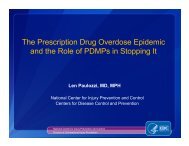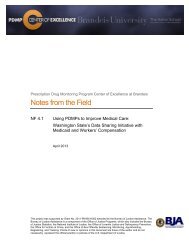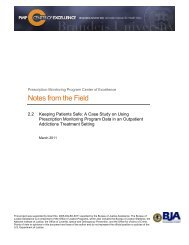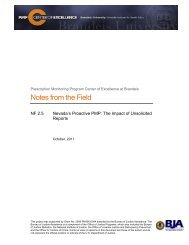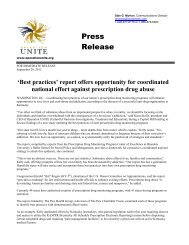Prescription Drug Monitoring Programs - PDMP Center of Excellence
Prescription Drug Monitoring Programs - PDMP Center of Excellence
Prescription Drug Monitoring Programs - PDMP Center of Excellence
Create successful ePaper yourself
Turn your PDF publications into a flip-book with our unique Google optimized e-Paper software.
<strong>Prescription</strong> <strong>Drug</strong> <strong>Monitoring</strong> <strong>Programs</strong>: An Assessment <strong>of</strong> the Evidence for Best Practices 46Current adoption status: A small but growing number <strong>of</strong> states statutorily require or recommend thatprescribers, pharmacists, and/or addiction treatment providers consult their <strong>PDMP</strong>s, sometimes only inspecific circumstances (NAMSDL, 2012b). In Nevada, statute NRS 639.23507 states that prescribers“shall” obtain a <strong>PDMP</strong> report when first prescribing a controlled substance for a new patient who theysuspect might be doctor shopping, and for patients for whom they have not prescribed controlledsubstances in the last year. In Oklahoma, prescribers must consult the <strong>PDMP</strong> when prescribingmethadone for treating pain. Recently passed legislation in Ohio requires its medical and pharmacylicensing boards to adopt rules mandating use <strong>of</strong> its <strong>PDMP</strong>, which they have done (Ohio AdministrativeCode Sections 4731-‐11-‐11 and 4729-‐5-‐20). In Louisiana, medical directors <strong>of</strong> pain clinics are nowresponsible for joining and querying the <strong>PDMP</strong> to help ensure compliance with a patient’s treatmentagreement. West Virginia requires that opioid addiction treatment programs access the <strong>PDMP</strong> whenbeginning treatment and at 90-‐day intervals, and Vermont requires use <strong>of</strong> its <strong>PDMP</strong> data by physicianswho treat patients for opioid dependence with buprenorphine (Office Based Opioid Treatment, orOBOT). Kentucky, Massachusetts, New York, and Tennessee have passed laws in 2012 requiring use <strong>of</strong>the <strong>PDMP</strong> by prescribers (NAMSDL, 2012b, communication with Massachusetts <strong>PDMP</strong>).Barriers to adoption: <strong>Monitoring</strong> required prescriber use <strong>of</strong> its system by a <strong>PDMP</strong> requires staff timeand resources that may be unavailable to some <strong>PDMP</strong>s, presenting a barrier to assuring that prescribersadopt this practice. Other potential barriers include resistance to mandates by providers and enactment<strong>of</strong> the required legislative or regulatory changes. However, should findings from existing initiatives provepositive, other states could be encouraged to undertake the necessary legislative and regulatorychanges to mandate utilization, and make resources available to implement utilization requirements.See Section V. Summary and Recommendations for a recommendation to study the efficacy <strong>of</strong>mandates in comparison to voluntary approaches with regards to increasing <strong>PDMP</strong> utilization.SummaryRationale: Mandating utilization may improve prescribing, patient safety, drug treatment, and licensingboard monitoring.Evidence <strong>of</strong> effectiveness: Accumulated experience, key stakeholder perceptions.Current adoption status: Several states mandate utilization by different categories <strong>of</strong> end users undervarying circumstances.Barriers to adoption: Provider resistance to mandates, need for legislative and/or regulatory reform,lack <strong>of</strong> program resources to monitor compliance.5. Institute financial incentivesRationale and evidence for effectiveness: Greater utilization <strong>of</strong> the <strong>PDMP</strong> by prescribers could perhapsbe encouraged by financial incentives, but little data exist on such approaches. One suggestion is tomake lower medical malpractice insurance premiums contingent on regular use <strong>of</strong> <strong>PDMP</strong> data. There isa need for studies examining whether prescriber use <strong>of</strong> <strong>PDMP</strong> data reduces the number <strong>of</strong> patient-‐‐initiated lawsuits stemming from alleged mis-‐prescribing <strong>of</strong> controlled substances; such findings couldhelp establish the rationale for charging <strong>PDMP</strong>-‐using prescribers lower insurance premiums. Similarly,



